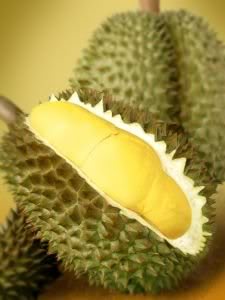

 Native in Brunei and other Asian countries. It bears fruit after 5 years. A seasonal fruit. Durian tree grows more than 26 meters from the ground. It has an oblong fruit weighing more or less 10 kilos. It has a thick rind and pointed spines. It has yellow-green color of the rind. It has an edible flesh or pulp. Inside the fruit has different compartment where the creamy-white or yellowish pulp is located. It has a seed with red-brown color.
Native in Brunei and other Asian countries. It bears fruit after 5 years. A seasonal fruit. Durian tree grows more than 26 meters from the ground. It has an oblong fruit weighing more or less 10 kilos. It has a thick rind and pointed spines. It has yellow-green color of the rind. It has an edible flesh or pulp. Inside the fruit has different compartment where the creamy-white or yellowish pulp is located. It has a seed with red-brown color.
In Asia, it was now locally and commercially produced. It is abundant during fruiting season. It has a very strong, pungent odor that can turned-off people to eat. Its offensive smell turned people away from the source.
The sweetness of the pulps is beyond compare with other fruits in the market. The first taste can let you look for the second. Once you become familiar with the taste, you will be looking and eating more.
During harvest time, it is not being plucked from the tree. They let it fall to the ground. This is the nature of this fruit during ripening stage. Its sweetness is due to sugars (fructose, sucrose).
Properties: pytonutrients, anti-oxidants, protein, vitamins and minerals. High in calories and carbohydrates, organosulfur compound, tryptophan, anti-fungal, anti-bacterial.
Durian is highly nutritious because of its vitamin E and iron. It has vitamin C and B. It helps lower cholesterol. Found to be a strong blood cleanser. It has high level of amino acid called trytophan found to pacify anxiety and stress. It is good for insomnia (hard to sleep). It raised the level of serotonin in the brain that will cause a happy feeling. It is good muscle builder due to its high level of soft protein. Many had experienced that durian acted as a aphrodisiacs which is good in sex problems. Its roots and leaves is good for the treatment of jaundice and fever.
The decoction of leaves and its fruit can cure swelling. It has a beneficial effect in skin condition. It replenishes energy. Good in the revitalization of the body. Used as supplement food for malnourished children. It has fats but does not have cholesterol.
A good laxative because of its fiber content by protecting the mucous of the colon membrane. It controls and eliminate cancer-causing chemicals that will affect the colon.
Because of its vitamin C, it has the the capacity to resist infection and eliminate free radicals harmful in nature. It has B-element (B-complex, B5,B6,B1), essential in body’s growth and development and resistance against many diseases. It has copper necessary in the production of red blood cells, iron for the formation of red blood cells. Its potassium acts an electrolyte of cells and body fluids. Potassium is the reason for controlled heart rate and normal blood pressure.
It is good for yeast infection because of iron helping the white blood cells of the body to make a chemical that will counter the infection. It decreases the effect of aging on the skin as it slow down the destruction of cells from free radicals.
Uses: Flavor base of sweet products (candy, biscuits, etc.), preparation of ice cream and milkshakes. Unripe durian can be served as vegetables for different menu. Durian seeds can be eaten roasted or boiled, frying. It is used as canned syrup.





